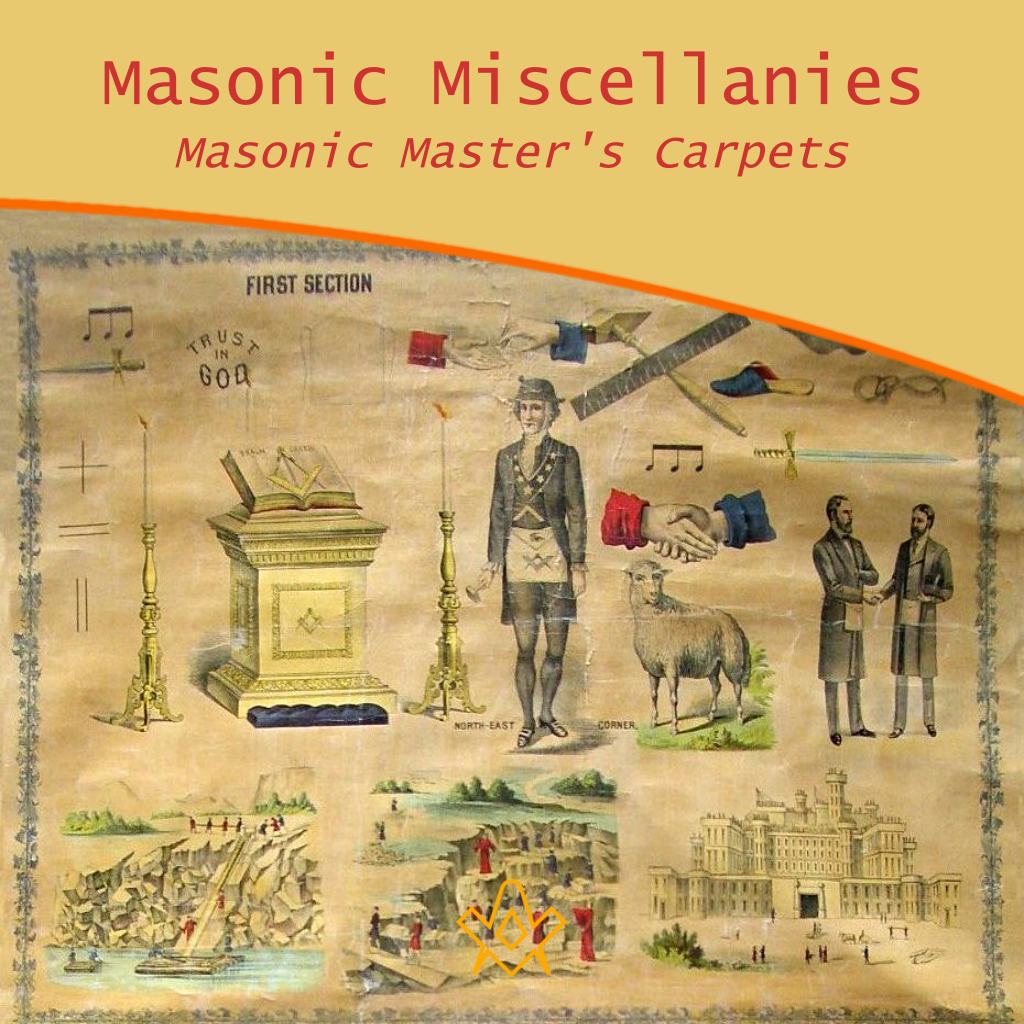Have you got a magic “Masonic Master’s Carpet” in your lodge? I say ‘magic’ with my tongue firmly in my cheek because (as far as I know) these fabulous works of art don’t bestow any mystical powers but can bestow some educational ones! However, considering their possible value today, they may magic up some interest (or funds).
What is a Master’s “Chart” or “Carpet”?
These “charts” or “carpets” were emblematical visuals for the instruction of Freemasonry. Lithographic posters were mounted on heavy-duty muslin, which ranged in size but the majority were around 3 x 4 feet.
They were essentially scrolls on rollers which could be pulled down as needed during Blue Lodge meetings of the 19th century, and utilised as teaching aides for the Worshipful Master and his lecturers to instruct new candidates in the symbolism of Craft Masonry.
Each chart/carpet featured many of the symbols we still recognise today:
the Sun, Moon and Stars, Jacob’s Ladder, King Solomon’s Temple, Pillars of J and B, the All-Seeing Eye, the Square and Compasses, the Ark and Rainbow, Beehive, 47th Problem of Euclid, Winged Hour Glass, Sword Pointing to a Naked Heart, and various other Working Tools.
The reason for the alternative use of the word “carpet” to describe the charts was that when the degrees were being explained to the initiates, the chart was taken off of the wall and rolled out on the floor of the Lodge room.
Who designed and made them?
In the mid-1800s, as Freemasonry was spreading across America, two Ohio companies were well-known for their fraternal materials.
Sherer Publications in Cincinnati was well-known for their Masonic degree carpets and lecture plates, and their creator, John Sherer, produced some interesting works on early Masonry. M.C. Lilley & Co. from Columbus became well-known for their magic lanterns and their hand-painted Magic Lantern glass slides.
Grand Master Richard A. Dickerscheid’s theme of this Masonic year is “Use the Tools.” The Sherer carpets and Lilley slides are both significant tools our local lodges use for educational purposes.
The images used on those carpets and slides found their way to the photographic slides, filmstrips, and videos still in use today.
As lodges embraced new technologies, often the old technologies ended up in storage or forgotten. Your lodge may have one of these hidden gems of Masonry just waiting to be revealed.
Source: Grand Lodge of Ohio website
John Sherer was a leading publisher of Masonic books and prints and is well-known for his portrait print commemorating George Washington as a Freemason.
A lithographer and publisher based in Cincinnati, Ohio, from 1847 to at least 1859.
He was in a partnership as Sherer & Rowse from 1847-1849 after which time he went into business under his own name, or as Sherer Publications.
His specialty was Masonic-themed prints but he also sold regalia and other supplies to lodges. Perhaps his best-known items were his Masonic Carpets, a set of charts mounted on muslin or canvas to be hung in Masonic lodges.
They showed the symbols and emblems associated with different lessons presented to aspiring Masons and were referred to during lectures to members. The visual representations of Masonic symbols were intended to serve as reminders of these lessons.
High Grade Supplies for Masonic Lodges” (catalog No. 69, c.1920s), describes some of Sherer’s “Celebrated” Masonic Carpets:
Sherer’s Celebrated Masonic Carpets – Mounted on canvas roller top and bottom; in three parts –
One for each degree, $13.50.
Single chart for Second Degree $4.50.
Charts mounted on spring rollers, in wall case, each $22.00.
1st Degree – We publish these in two styles, beautifully lithographed in numerous colors. They are without exception the finest Charts for the Lodge Room ever devised.
The Sherer Carpets have been the standard work for the Lodge Room for over thirty years. The late John Sherer, their author, largely devoted his life to arranging and perfecting these beautiful works for the Lodge Room instructions, and so well did he succeed that no one has ever been able to compile a Chart that would stand for a moment when compared with Sherer’s.
Nearly every Grand Lodge in America has officially endorsed the Sherer Carpets and recommended each subordinate Lodge to purchase one, and hundreds of Grand Officers have declared these Carpets absolutely indispensable in conferring the degrees intelligently.
The emblems are arranged in systematic order to correspond with the several lectures, and give more light to the candidate than can be done in any other way.
They print indelibly upon the every Mason’s mind the true alphabet of Masonic symbols. Thousands of Lodges have purchased them, and Bob Morris truly says:
‘The present generation of Masons have been educated symbolically by Brother Sherer’s Carpets.’
2nd Degree – Latest improved addition, in map form, mounted on heavy muslin, on roller all ready to hang in the Lodge.
Embraces all the emblems of the Blue Lodge Degrees, correctly and systematically arranged by section and Degree, with a ground floor view, or correct representation of a Lodge in each Degree.
All the work is so distinct that brethren in distant parts of the hall my follow the Worshipful Master as he points out the emblems, and refresh their memories as to the meaning of these mystic symbols.
This is unquestionably the most beautiful, correct and elaborate Carpet ever devised. Size 6 X 6 feet. Price $10.00
3rd Degree – In three parts; each degree on a separate chart with ground floor view of a Lodge in each Degree.
Size of Chart 3 X 4 feet. Lithographed and mounted on rollers – map form.
The Charts are lighter to handle and the candidate has before him only the emblems of the Degree he has just taken.
Price per set, three charts, $10.00
Besides the carpets, Sherer also published “Sherer’s Gems of Masonry” (1859), a book in which the symbols of the three Blue Lodge degrees and four of the York Rite degrees are explained, referring to places in the Preston Ritual, Anderson’s Constitutions, Ahimon Rezon, and Holy Scriptures.
They were offered with original Sherer images and commentary and poetry of Brother Rob Morris, creator of Order of the Eastern Star who was serving as Grand Master of Kentucky at the time.
Later he produced “The Masonic Ladder” (1866), and “Sherer’s Masonic Monitor” (1867) containing symbols and explanations of the Blue Lodge and York Rite degrees with commentary by MWB Morris, and combined with the Preston-Webb Ritual Monitor.
He issued his charts in 1874, and a second printing of the same edition was released by R.W. Carroll & Co. in Cincinnati.
The book version was lithographed by Ehrgott, Forbriger & Co. in Cincinnati, Ohio, the first steam powered press west of New York City.
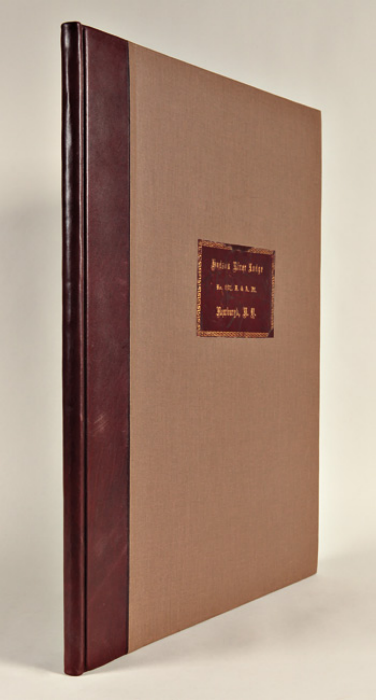
The images in Sherer’s publications were later adapted to produce lecture slides and videos that are still in use in Masonic lodges today.
John Sherer’s rare text “Sherer’s Masonic degree book of ancient Craft Masonry: being a correct presentation of the emblems of the blue lodge degrees of Entered Apprentice, Fellow Craft, and Master Mason according to the American system”, currently sells for £6,300.03!
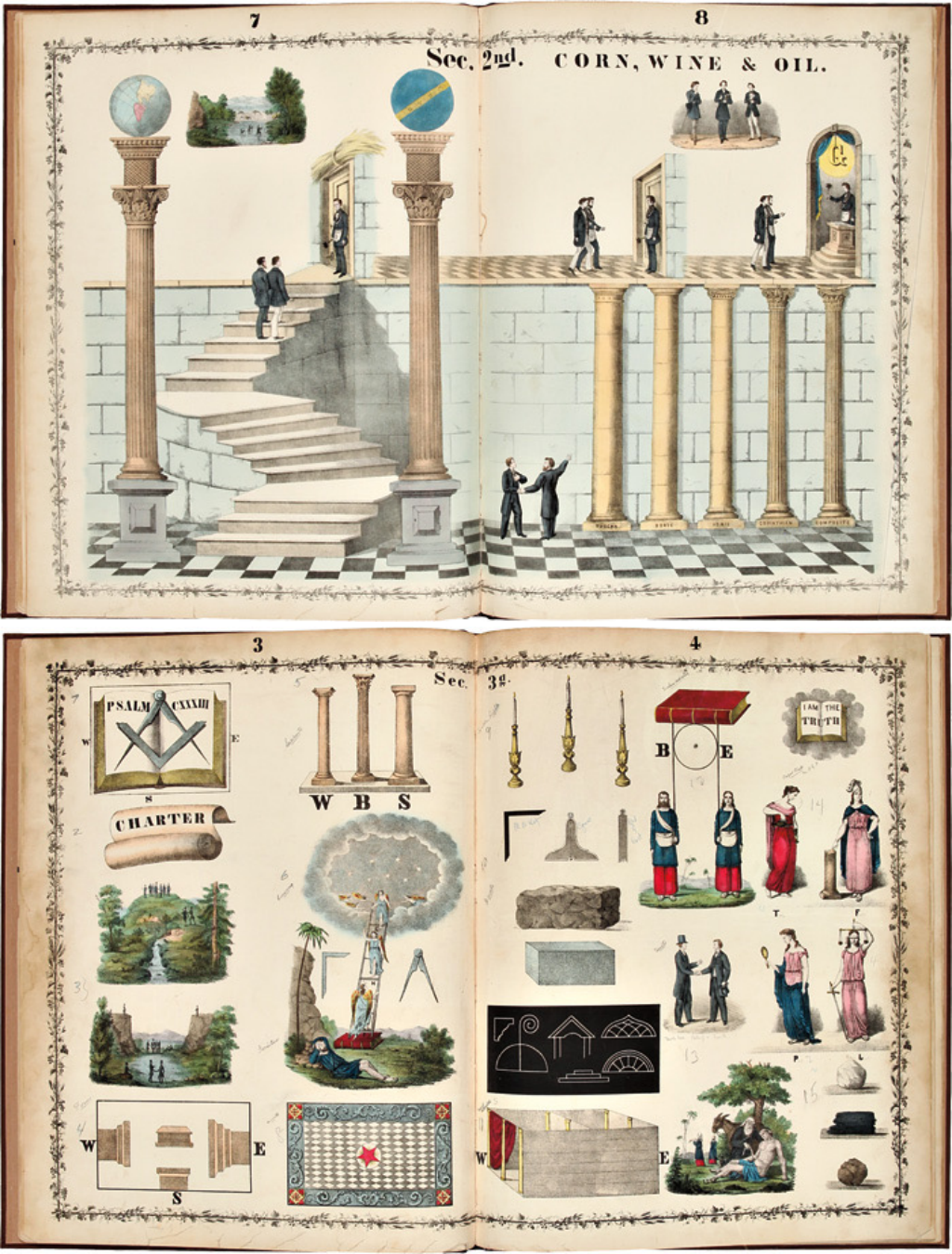
Images via AbeBooks.co.uk
You can view some of the original images via the link here, courtesy of a post on r/freemasonry by reddit.com/user/bmkecck/ (2017)
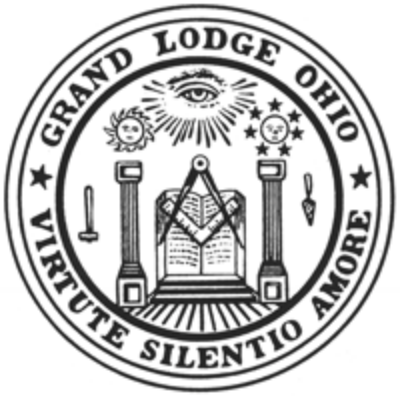
Check out this presentation on John Sherer by RWB Chad Kopenski from the Grand Master’s Virtual Roadshow –
The Grand Lodge of Ohio. https://vimeo.com/494321482/5d03e679d3
Recent Articles: Masonic Miscellanies
 Masonic Miscellanies - The Amulet of the Ladder Explore the cosmic significance of the Ladder in ancient Egyptian mythology through Wallis Budge's "Egyptian Magic." Discover how this profound symbol bridges the mortal and divine, encapsulating the Egyptians' fervent afterlife aspirations with a blend of myth, magic, and material culture. Dive into the celestial ascent of Osiris and mortal souls. |
 Masonic Miscellanies - Adulterine Gilds Guilds, the associations that shaped medieval European society, were more than just organizations of artisans and merchants. They played a vital role in the economic and social development of towns and cities. This exploration delves into the intriguing concept of adulterine gilds and their interconnectedness with guilds, offering insight into the significance of legal authorization and recognition in medieval Europe. |
 Masonic Miscellanies - Masonic Orb Discover the fascinating world of Masonic ball watch fobs, intricately crafted with tiny pyramids that form a cross when opened. These decorative accessories were all the rage in the late 1800s and early 1900s, and they still hold a certain allure today. Explore the different varieties and symbols found on these unique pieces that carry deep Masonic meaning. |
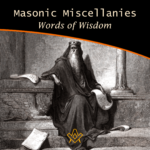 Masonic Miscellanies – Words of Wisdom Uncover timeless wisdom from King Solomon to Albert Pike in our latest Masonic Miscellanies, a treasure trove of insights for Masons. Journey through the ages and glean inspiring sayings, reflecting on their profound influence on Masonic principles. An enriching read for the enlightened. |
 Masonic Miscellanies - Symbolism of the Right Hand Unlock the enigmatic realm of Freemasonry as we delve into its age-old symbols, rituals, and philosophies. This thought-provoking exploration, drawn from Mackey's Revised Encyclopedia of Freemasonry, focuses on the iconic 'right hand' symbol - its rich history, universality, and profound significance. |
 Masonic Miscellanies - Order of the Secret Monitor Unveil the mystery of Freemasonry with 'The Order of the Secret Monitor'. Discover this lesser-known appendant order, its unique rituals, and the profound teachings it offers. Explore the bonds of friendship and brotherhood it fosters, all wrapped in an intriguing cloak of mystery. Your journey into the depths of Masonic wisdom begins here. |
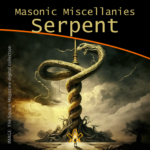 Masonic Miscellanies - The Symbol of the Serpent As a symbol, the serpent obtained a prominent place in all the ancient initiations and religions. |
 Masonic Miscellanies - The Four Veils in Royal Arch Masonry What are the four veils in Royal Arch Masonry? And what is the 'Ceremony of Passing the Veils'? Although common throughout Scotland, Ireland and the United States, it is mostly unknown in England, presently only worked in the Province of Bristol. ( and by dispensation ) |
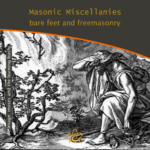 Masonic Miscellanies - Bare feet and Freemasonry A candidate for initiation into a Masonic Lodge often finds the requirements which he/she must fulfil somewhat odd. The mode of preparation often remains a puzzle, since the ritualistic explanation is not offered in full. Why are we 'slipshod' or "bare-footed" in Masonic Ritual? |
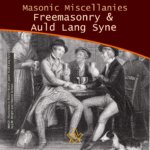 Masonic Miscellanies – Freemasonry and Auld Lang Syne Millions of people throughout the world will sing Auld Lang Syne to see out the Old Year. Few will know all the words, fewer still know what they mean, or that there is a link to Freemasonry. |
 Masonic Miscellanies - The Mosaic Pavement - why mosaic, why pavement? We are all familiar with the black and white chequered flooring of the Masonic lodge but where did it originate? There are a few theories… |
 Masonic Miscellanies – Masonic Master's Carpets Have you got a magic "Masonic Master's Carpet" in your lodge? I say 'magic' with my tongue firmly in my cheek because (as far as I know) these fabulous works of art don't bestow any mystical powers but can bestow some educational ones! However, considering their possible value today, they may magic up some interest (or funds). |
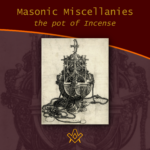 Masonic Miscellanies – The Pot of Incense Just when the pot of incense became an emblem of the third section of the Sublime Degree can not be stated with certainty. It is, apparently, an American invention or addition. But what does it symbolise? |
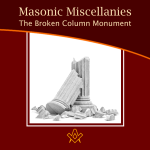 Masonic Miscellanies - The Broken Column Monument The story of the broken column was first illustrated by Amos Doolittle in the "True Masonic Chart" by Jeremy Cross, published in 1819. |
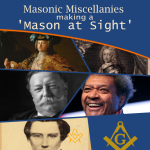 Masonic Miscellanies - Making a 'Mason at Sight' What does it mean to make a 'Mason at sight', and who was made one? |
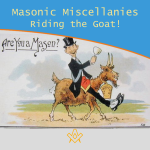 Masonic Miscellanies - Riding the Goat! Many Freemasons will have come across the phrase 'riding the goat', and will no doubt have been the butt of a joke about it (sorry, I couldn't resist!) But what does it mean and where did the phrase come from? |
 Masonic Miscellanies - What are the 'three dots'? Three dots or points in an upright triangular shape ∴ is most commonly known as the 'therefore' sign – so why is it used in Freemasonry? |
 Masonic Miscellanies - Keep Within Compass This month we discover a series of allegorical prints warning us to "Keep within Compass and you shall be sure, to avoid many troubles which others endure." |
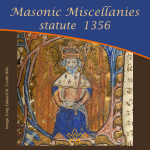 Masonic Miscellanies - statute 1356 Further to the reference in the article – The Builders - 6 - Free-Masons 'a statute was enacted against the Free-masons in 1356' – Regulations for masons who are hewers, on the one hand, and the light masons and setters on the other. |
 Masonic Miscellanies - An Anti-Masonic 'Apron'? The Anti-Masonic 'Apron' was created during the 1832 Presidential election in USA. It was not Ani-masonic. And it was not an apron. Read on to find out what and why it was created. |
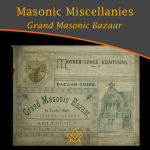 Masonic Miscellanies - Grand Masonic Bazaar (1895) Grand Masonic Bazaar (1895); to raise funds to clear the debt incurred by “Mother Kilwinning” in rebuilding their Lodge. |
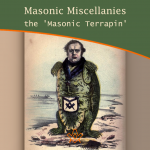 Masonic Miscellanies - the 'Masonic Terrapin' A satirical book from 1851 includes a bizarre caricature of a 'Masonic Terrapin' - all I can say is 'read on'… |
 Masonic Miscellanies - Masonic Bookplates You probably know what a bookplate is for, but did you know that the earliest known book mark/label dates from the reign of Amenhotep III in Egypt around 1391−1353 BCE?! |
 Masonic Miscellanies - Freemasonry & Bees Freemasonry & Bees - what's the buzz? The bee was among the Egyptians the symbol of an obedient people, because, says Horapollo, of all insects, the bee alone had a king. |
 Masonic Miscellanies - The mystery of the Tattooed Freemason In 1894, the body of a drowned man was found in the Bay of San Francisco - what they discovered was amazing. |
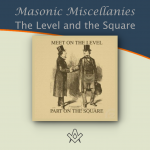 Masonic Miscellanies - The Level and the Square (A Poem) The Level and the Square (A Poem) - "We meet upon the Level, and we part upon the Square – |
 Masonic Miscellanies - The Mystic Tie What is the 'Mystic Tie'? Clue: it's not an item of neckwear! |
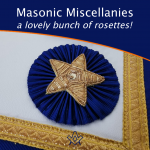 Masonic Miscellanies - A lovely bunch of rosettes! Where did the origin of the use of rosettes on Masonic aprons come from ? |
 Masonic Miscellanies - The Lodge of Sorrow The Lodge of Sorrow - Extracted General Ahiman Rezon, by Daniel Sickles, [1868] |
 Masonic Miscellanies - Memento Mori Memento Mori - a Masonic reminder to make your mark on the world |
 Masonic Miscellanies - A closer look at the Level and the Plumb-rule A closer look at the Level and the Plumb-rule |
 Masonic Miscellanies - The Symbolism of the Gloves The Symbolism of the Gloves and why Freemasons wear white gloves |
 Masonic Miscellanies - Will the real James Anderson please stand up? Will the real James Anderson please stand up? |
 Masonic Miscellanies - The Legend of the Third Degree The most important and significant of the legendary symbols of Freemasonry is, undoubtedly, that which relates to the fate of Hiram Abif. |
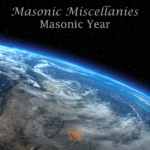 Masonic Miscellanies - Masonic Calendar Why do Freemasons use different 'years' to our regular calendar? |
 Masonic Miscellanies - What is a 'Lewis'? The English word 'Lewis' is a term belonging to operative Masonry, and signifies an iron cramp, which is inserted in a cavity prepared for the purpose in a large stone. |
 Masonic Miscellanies - From J.S.M. Ward Ever wondered why masons had to be 'free' or why we have a Tyler? |
masonic knowledge
to be a better citizen of the world
share the square with two brothers

click image to open email app on mobile device


